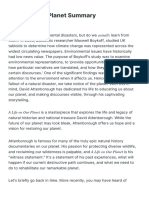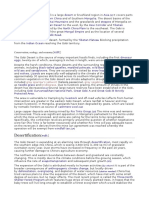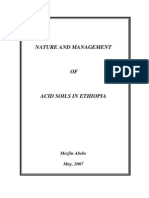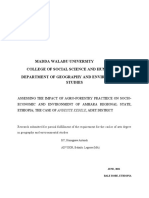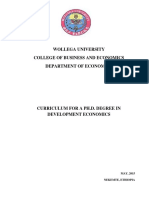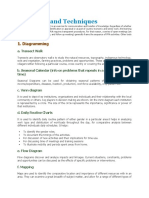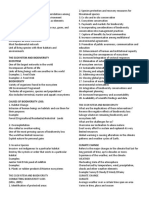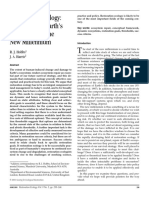Environmental Impact Assessment Guideline of Ethiopia
Environmental Impact Assessment Guideline of Ethiopia
Uploaded by
Tamirat WorkuCopyright:
Available Formats
Environmental Impact Assessment Guideline of Ethiopia
Environmental Impact Assessment Guideline of Ethiopia
Uploaded by
Tamirat WorkuOriginal Description:
Copyright
Available Formats
Share this document
Did you find this document useful?
Is this content inappropriate?
Copyright:
Available Formats
Environmental Impact Assessment Guideline of Ethiopia
Environmental Impact Assessment Guideline of Ethiopia
Uploaded by
Tamirat WorkuCopyright:
Available Formats
1.
As a reference material - to assist proponents and consultants in carrying
out their environmental assessment related tasks by giving out the necessary
information and by portraying the process flow.
2. providing a consistent and good practice approach to EIA in Ethiopia
3. Providing background information for the context of EIA in Ethiopia
4. Assisting the authorities in determining their roles and responsibilities as
decision-makers in the EIA process
the following:
To fulfill the above purposes the guideline embodies the following contents:
It is a comprehensive description of each of the phases within an EIA process
and identifies the roles and responsibilities of each party engaging in the EIA
process.
Chapter 5 identifies the issues and impacts that may be associated with
development in some of the key sectors in Ethiopia.
Review of CHAPTER 2: Environmental Assessment and Management in
Ethiopia
As a background the document states that past developmental projects didnt
include environmental concerns in their planning and operation which has led to a
seriously degraded environment in the country; and to ensure sustainable
development in the future - environmental assessment and management has been
recognized as an effective tool which is to be included in future development
proposals.
In its Legislative and Policy Context topic of this guideline it briefly discusses the
following:
The Constitution of the FDRE
o Article 43: The Right To Development
o Article 44: Environmental Rights , and
o Article 92: Environmental objectives it is declared that
Environmental
Protection
organs
Establishment
proclamation
(proc.no.295/2002)
Environmental Impact Assessment Proclamation (Proc. no. 299/2002)
Environmental Pollution Control Proclamation (Proc. no. 300/2002)
Environmental Policy of Ethiopia (EPE, 1997)
Chapter 2 of the guideline also include the objectives, core values and the principles
of EIA.
The primary objective of EIA is to ensure that impacts of projects, policy and
programs, etc. are adequately and appropriately considered and mitigation
measures for adverse significant impacts incorporated when decisions are taken.
The four core values of EIA are:
Sustainability - the EA process should result in sustainable development by
establishing long-term environmental safe guards.
Integrity - the EIA process will confirm to agreed and established
requirements.
Utility - the EIA process will provide balanced, credible information for
decision making.
Equity - that EIA ensures fairness in the distribution costs or benefits.
And the guiding principles of EIA are:
Early application - proactive consideration and integration of environmental
concerns at the earliest stages of the conceptualization of the projects,
programs or policies.
Participation - appropriate and timely access and opportunity to the
process for all interested and affected parties.
Issues based - the focus of an EA is on the resolution of major issues of
significant impacts.
Consider alternatives: all feasible options to a project, policies, programs
or its components like site, processes, products, raw materials etc. including
the no go option should be considered.
Accountability - refers to answerability of a proponent, consultant and
environmental agencies for their respective roles and responsibilities.
Flexibility - the assessment process should be able to adapt to deal
efficiently with changing circumstances and decision making situation.
Credibility - assessments and reviews are undertaken with professionalism
and objectivity.
Time and Cost-effectiveness - the assessment process, its outcomes and
decision taking will ensure environmental protection at the least cost and
within reasonable time to society and developer alike.
Transparency - all assessment decisions, and their basis, should be open
and accessible to the public.
Supportive - the review and decision making process should enhance and
support sustainable development and environmentally friendly investment
efforts.
Conservation based- the EA process should strive to promote conservation
based development. Integrating conservation elements in the development
planning that extend beyond conventional impact fixation approach can do
this.
Practicality - the information and outputs provided by the assessment
process are readily usable in the decision -making and planning.
Operating Principles of the EIA
EIA is undertaken to:
modify and improve design,
ensure efficient resource use,
enhance social aspects,
identify measures for monitoring and managing impacts,
promote sustainable productivity within the natural and social system
capacity,
meet environmental requirements and make continuing improvement in
environmental performance,
provide accurate and appropriate information for sound decision,
BENEFITS OF EIA INCLUDES:
more environmentally sustainable design,
better compliance with standards,
saving in capital and operating costs,
reduced time and costs for approval,
avoids later plan adaptations,
reduces health costs,
increased project acceptance,
Review of Chapter 3: The Environmental Impact Assessment Process
You might also like
- How Mining Works: W. Scott DunbarDocument1 pageHow Mining Works: W. Scott DunbarTamirat WorkuNo ratings yet
- The Gulf States and the Horn of Africa: Interests, influences and instabilityFrom EverandThe Gulf States and the Horn of Africa: Interests, influences and instabilityNo ratings yet
- Technical Study Kaolin ProjectDocument201 pagesTechnical Study Kaolin ProjectTamirat Worku100% (1)
- DRM Spif 2014 - FinalDocument65 pagesDRM Spif 2014 - FinalMlyrd EmrnNo ratings yet
- A Life On Our PlanetDocument13 pagesA Life On Our PlanetStefan RafaelNo ratings yet
- Didier DrogbaDocument3 pagesDidier DrogbaIñigo Sierra100% (1)
- Little Mirrless and UNIDO Approach - A ComparisionDocument10 pagesLittle Mirrless and UNIDO Approach - A ComparisionThirumanas Kottarathil K RNo ratings yet
- Peter Bowler The Fontana History of The Environmental SciencesDocument665 pagesPeter Bowler The Fontana History of The Environmental SciencesEmma FlashNo ratings yet
- Desertification: Conservation, Ecology, and EconomyDocument5 pagesDesertification: Conservation, Ecology, and EconomyrNo ratings yet
- Unit-1: Compiled By: Shambhu Kumar Mishra (B. Sc. 3 Year, 2 Half)Document113 pagesUnit-1: Compiled By: Shambhu Kumar Mishra (B. Sc. 3 Year, 2 Half)Prakriti Sahitya ManchNo ratings yet
- Environmental Impact Assessment Guideline of EthiopiaDocument3 pagesEnvironmental Impact Assessment Guideline of EthiopiaTamirat Worku83% (6)
- Eia LastDocument156 pagesEia LastNaima Ahmed AbdiNo ratings yet
- College of Finance, Management and Development Department of Public Financial Management (PFM)Document5 pagesCollege of Finance, Management and Development Department of Public Financial Management (PFM)TongNo ratings yet
- Big Push EthiopiaDocument19 pagesBig Push EthiopiaPhoulLit100% (1)
- ESMF Tigray - Training - 2023Document97 pagesESMF Tigray - Training - 2023Brhane WeldegebrialNo ratings yet
- Proc NO. 89-1997 Federal Rural Land AdministrationDocument4 pagesProc NO. 89-1997 Federal Rural Land AdministrationTekeba BirhaneNo ratings yet
- Proc No. 299-2002 Environmental Impact AssessmentDocument8 pagesProc No. 299-2002 Environmental Impact AssessmentBirhanu Dagnew100% (1)
- Kebede Kassa First Draft CommentedDocument73 pagesKebede Kassa First Draft CommentedBereketNo ratings yet
- PSNP5 - Ethiopian - Sep, 2020Document399 pagesPSNP5 - Ethiopian - Sep, 2020Dejen AlemayehuNo ratings yet
- Proclamation No 103-1998 Capital Goods Leasing BsuinessDocument4 pagesProclamation No 103-1998 Capital Goods Leasing BsuinessTSEDEKENo ratings yet
- Bishoftu Forem2Document29 pagesBishoftu Forem2Aida Mohammed100% (1)
- Soils Acid ManagementDocument99 pagesSoils Acid Managementbig john100% (9)
- 1 2021.6.28 CIP Manual UpdateDocument28 pages1 2021.6.28 CIP Manual UpdateOsman Osman100% (1)
- Privatization and Deregulation in Ethiopia - Final - Docx1Document33 pagesPrivatization and Deregulation in Ethiopia - Final - Docx1kassahun meseleNo ratings yet
- Revised TOR - EnglishDocument3 pagesRevised TOR - EnglishYabibal AddisNo ratings yet
- Mesfin AssefaDocument246 pagesMesfin Assefalibanhaji25No ratings yet
- The Practices and Challenges of Urban Food Security PDFDocument107 pagesThe Practices and Challenges of Urban Food Security PDFSabir ImamNo ratings yet
- Bench-Sheko Cultural CenterDocument40 pagesBench-Sheko Cultural Centerabrham astatikeNo ratings yet
- Assessment of Budget Preparation, Utilization and Evaluation in The Case of Negelle Borena Town Municipality, Oromia Region, EthiopiaDocument15 pagesAssessment of Budget Preparation, Utilization and Evaluation in The Case of Negelle Borena Town Municipality, Oromia Region, EthiopiaMegersa Abdisa100% (1)
- Youth Unemployment - Causes and ConsequencesDocument2 pagesYouth Unemployment - Causes and Consequencesapi-26075761100% (3)
- Presentation Oro Part IDocument25 pagesPresentation Oro Part IfeyeraNo ratings yet
- Madda Walabu University College of Social Science and Humanities Department of Geography and Environmental StudiesDocument42 pagesMadda Walabu University College of Social Science and Humanities Department of Geography and Environmental Studieszelalem wegayehu100% (2)
- Chapter IIIDocument54 pagesChapter IIINesri Yaya100% (2)
- Research PresentationDocument22 pagesResearch PresentationeferemNo ratings yet
- One WashFINAL Draft Project Document 2019Document99 pagesOne WashFINAL Draft Project Document 2019JamalNo ratings yet
- Effect of Informal SettlementDocument22 pagesEffect of Informal Settlementworku teshiteNo ratings yet
- Master Thesis Aron AsgedomDocument64 pagesMaster Thesis Aron AsgedometayhailuNo ratings yet
- GNAD Bahirdar Aspalt To New Drainage (100m)Document10 pagesGNAD Bahirdar Aspalt To New Drainage (100m)Asmerom Mosineh100% (1)
- Ethiopia Seed Sector Baseline StudyDocument116 pagesEthiopia Seed Sector Baseline StudyMekon-Engineering Mke100% (2)
- Tafese Toma ProposalDocument27 pagesTafese Toma Proposaltsbaye WaNo ratings yet
- The Potential For Public Private Partnership in The Case of Ethiopian ContextDocument85 pagesThe Potential For Public Private Partnership in The Case of Ethiopian ContextTefera Thaimanot100% (1)
- Oromiya Regional ProfileDocument15 pagesOromiya Regional ProfileGuddisaa Gabbisaa100% (3)
- Assessment On Opportunities Gaps and Challenges On Land Based Investment in Oromia RegionDocument41 pagesAssessment On Opportunities Gaps and Challenges On Land Based Investment in Oromia RegionDejeneNo ratings yet
- Construction Law PPT 20 4 2024Document103 pagesConstruction Law PPT 20 4 2024BORENANo ratings yet
- Digital Terrain Analysis in A GIS Environment. Concepts and DevelopmentDocument2 pagesDigital Terrain Analysis in A GIS Environment. Concepts and Developmentfox wolfNo ratings yet
- Federal Negarit Gazeta: &olo&.1a J T:'-' J It If)Document6 pagesFederal Negarit Gazeta: &olo&.1a J T:'-' J It If)Abaa MacaaNo ratings yet
- Tofiq Project Proposal ReportDocument34 pagesTofiq Project Proposal ReportBiniyam Yitbarek100% (1)
- PHD Final CarriculumDocument17 pagesPHD Final CarriculumIsubalew Daba100% (3)
- Physiology of Metabolism and EnergyDocument44 pagesPhysiology of Metabolism and EnergyShilvia JungNo ratings yet
- Final ESIA of Shekhusen Mechara Road Project July 2022Document264 pagesFinal ESIA of Shekhusen Mechara Road Project July 2022yaredgirmaworkuNo ratings yet
- AgriculturalProjectPlanningandAnalysis ProjectBook PDFDocument504 pagesAgriculturalProjectPlanningandAnalysis ProjectBook PDFfahad acobNo ratings yet
- ASMERABEKELEDocument112 pagesASMERABEKELELola MergoNo ratings yet
- The Municipal Development Partnership (Eastern and Southern Africa)Document33 pagesThe Municipal Development Partnership (Eastern and Southern Africa)Anonymous modfBhExSNo ratings yet
- Aawsa EvaluationDocument4 pagesAawsa EvaluationaberraNo ratings yet
- Training ProjectDocument11 pagesTraining ProjectPavlo Andre AbiyNo ratings yet
- Ethiopian Tourism Strategic Plan ReviewDocument14 pagesEthiopian Tourism Strategic Plan ReviewAwetahegn Hagos100% (1)
- A Socio-Economic History of North Shäwa, ETHIOPIA (1880s-1935)Document315 pagesA Socio-Economic History of North Shäwa, ETHIOPIA (1880s-1935)didierNo ratings yet
- Innovation4resilience - Concept Note Template Component 1Document4 pagesInnovation4resilience - Concept Note Template Component 1simbiroNo ratings yet
- Getaneh C Abvm - Docx - 0Document48 pagesGetaneh C Abvm - Docx - 0Mehari TemesgenNo ratings yet
- Government Policy Towards Informal Sector in EthiopiaDocument24 pagesGovernment Policy Towards Informal Sector in EthiopiaRobelNo ratings yet
- PRA Tools and Techniques: 1. DiagrammingDocument3 pagesPRA Tools and Techniques: 1. DiagrammingCreative PointNo ratings yet
- Final Druft Proposal 1Document56 pagesFinal Druft Proposal 1Ethio KidsNo ratings yet
- Adisu Ppt. EndDocument41 pagesAdisu Ppt. Endafewrk Wndimu (buxe)100% (1)
- Training Africa's Youth in Waste Management and Climate Change: A Textbook for the Youth in Africa's Primary and Junior Secondary SchoolsFrom EverandTraining Africa's Youth in Waste Management and Climate Change: A Textbook for the Youth in Africa's Primary and Junior Secondary SchoolsNo ratings yet
- Environmental Impact Assessment Guideline of EthiopiaDocument3 pagesEnvironmental Impact Assessment Guideline of EthiopiaTamirat Worku100% (2)
- Environmental Impact AssesmentDocument3 pagesEnvironmental Impact AssesmentAfnan AhmadNo ratings yet
- Progressivism Anchored by Constitutionalism: For Dignity & HopeDocument9 pagesProgressivism Anchored by Constitutionalism: For Dignity & HopeTamirat WorkuNo ratings yet
- Excavation Study NotesDocument1 pageExcavation Study NotesTamirat WorkuNo ratings yet
- Report of The Ad Hoc Working Group On Defining Critical Raw MaterialsDocument41 pagesReport of The Ad Hoc Working Group On Defining Critical Raw MaterialsTamirat WorkuNo ratings yet
- 09162014114959monograph Chromite PDFDocument162 pages09162014114959monograph Chromite PDFTamirat WorkuNo ratings yet
- MedicalReportForm KDI PDFDocument2 pagesMedicalReportForm KDI PDFTamirat WorkuNo ratings yet
- Callicott CDocument475 pagesCallicott CMiguel Valderrama ZevallosNo ratings yet
- 5th Grade Ecosystem Lesson Plan (FINAL)Document8 pages5th Grade Ecosystem Lesson Plan (FINAL)jstod2018No ratings yet
- List of Keystone SpeciesDocument3 pagesList of Keystone Speciesapi-234891239No ratings yet
- Mammal Identification and Tracking Guide PDFDocument25 pagesMammal Identification and Tracking Guide PDFΤασοςNo ratings yet
- Assessment of The Mobility Week in Portugal FinalDocument17 pagesAssessment of The Mobility Week in Portugal Finalapi-292520116No ratings yet
- PHD Research Proposal - The Economic Impact of Tourism On Vail, Colorado - Brian M Touray MSCDocument8 pagesPHD Research Proposal - The Economic Impact of Tourism On Vail, Colorado - Brian M Touray MSCCANADIAN INSTITUTE OF TOURISM AND SUSTAINABLE LIVELIHOODS - CITSL- Brian TourayNo ratings yet
- NambuccaRiver and Deep Creek Catchment Report Card 2018 PDFDocument1 pageNambuccaRiver and Deep Creek Catchment Report Card 2018 PDFmichaelNo ratings yet
- 5 Elements of Wildlife Photography ProcessDocument58 pages5 Elements of Wildlife Photography ProcessGogus Frack50% (2)
- Foresters LawDocument3 pagesForesters LawyennaNo ratings yet
- Sustainable Building Material For Green Building Construction, Conservation and RefurbishingDocument7 pagesSustainable Building Material For Green Building Construction, Conservation and RefurbishingghchgNo ratings yet
- Trans Miss Able Disease HandbookDocument195 pagesTrans Miss Able Disease HandbookAhmed NickovNo ratings yet
- PLANETARY NETWORKS NotesDocument2 pagesPLANETARY NETWORKS NotesIekzkad RealvillaNo ratings yet
- Forest Fragmentation and Landscape Connectivity Change Associated With Road Network Extension and City Expansion A Case Study in The Lancang River ValleyDocument9 pagesForest Fragmentation and Landscape Connectivity Change Associated With Road Network Extension and City Expansion A Case Study in The Lancang River ValleyJosé David QuevedoNo ratings yet
- Interpretation and ArchaeotourismDocument582 pagesInterpretation and ArchaeotourismmjandaliNo ratings yet
- Forest Farming-Understanding AgroforestryDocument2 pagesForest Farming-Understanding AgroforestryAlexandraNo ratings yet
- Abu Dhabi Recommended Plant PDFDocument30 pagesAbu Dhabi Recommended Plant PDFelmerbarrerasNo ratings yet
- The Effects of Population Growth On LandDocument13 pagesThe Effects of Population Growth On LandShubham AnandNo ratings yet
- Biomimicry in ArchitectureDocument28 pagesBiomimicry in ArchitectureJahnavi Bhatt100% (2)
- Lime Hollow Strategic Development PlanDocument35 pagesLime Hollow Strategic Development PlanEd Chops FitzGerald100% (1)
- Directed Study - Day 2 - Pyramids Graphic OrganizerDocument2 pagesDirected Study - Day 2 - Pyramids Graphic Organizerapi-240119100No ratings yet
- Extracted Pages From Cambridge Primary Science LB 2Document20 pagesExtracted Pages From Cambridge Primary Science LB 2hangntt03No ratings yet
- Hobbs and Harris 2001Document8 pagesHobbs and Harris 2001BaileyNo ratings yet
- Save Soil Digital FlyerDocument1 pageSave Soil Digital FlyerRituNo ratings yet
- Green Challenge Fund Application Guidelines and Evaluation CriteriaDocument13 pagesGreen Challenge Fund Application Guidelines and Evaluation CriteriaAbima swabiriNo ratings yet
- Water Resources Assignment Class 10 SOCIAL SCIENCEDocument3 pagesWater Resources Assignment Class 10 SOCIAL SCIENCEVedanshi TalwarNo ratings yet
- Sas #3 Cri 196Document13 pagesSas #3 Cri 196Jeanny Ann BalboaNo ratings yet




